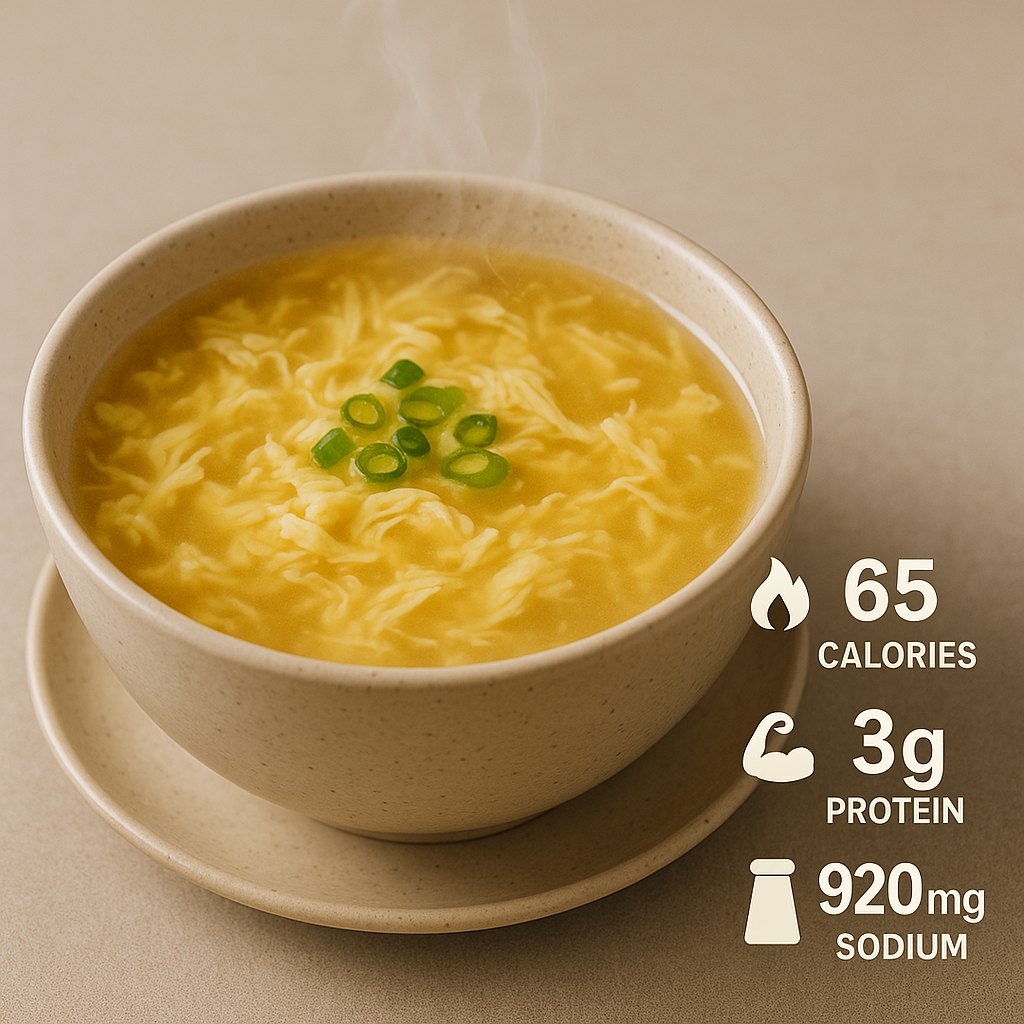Disclaimer
Nutritional values are approximate and can vary by recipe. This article is for informational purposes only and does not substitute for medical or dietary advice. Consult a healthcare provider before making dietary changes if you have hypertension, cholesterol issues, or food allergies.
Warm, silky, and comforting — egg drop soup has long been a favorite in Chinese cuisine. Made from simple ingredients like eggs, broth, and cornstarch, it’s both nourishing and light, making it a go-to meal for those looking for comfort without heavy calories.
But what’s really inside a bowl of egg drop soup? Is it as healthy as it tastes simple? Understanding egg drop soup nutrition can help you decide how it fits into your diet — whether you’re counting calories, managing sodium intake, or just aiming for balanced eating.
What Is Egg Drop Soup?
Egg drop soup (also called egg flower soup) is a traditional Chinese dish made by slowly pouring beaten eggs into hot broth, creating delicate ribbons or “flowers” of cooked egg.
Its base typically includes:
- Chicken or vegetable broth
- Beaten eggs
- Cornstarch (for thickness)
- Salt, pepper, and sometimes soy sauce
- Green onions or scallions for garnish
This simple recipe can vary widely — some versions include tofu, mushrooms, spinach, or corn, while restaurant versions often contain added seasonings or starch for texture.
Egg Drop Soup Nutrition Data (Per 1 Cup / 245 g Serving)
| Nutrient | Amount |
|---|---|
| Calories | 65 kcal |
| Protein | 3.3 g |
| Total Fat | 2.3 g |
| Saturated Fat | 0.6 g |
| Cholesterol | 55 mg |
| Sodium | 920 mg |
| Carbohydrates | 7.3 g |
| Sugars | 0.9 g |
| Fiber | 0.3 g |
| Calcium | 22 mg |
| Iron | 0.5 mg |
| Potassium | 105 mg |
| Vitamin A | 80 IU |
| Vitamin C | 1.5 mg |
Values based on a traditional Chinese restaurant-style recipe. Homemade versions with low-sodium broth can have significantly lower sodium content.
Calories in Egg Drop Soup
A standard cup of egg drop soup contains 60–80 calories, depending on the recipe. This makes it one of the lowest-calorie soups available, ideal for light meals, appetizers, or those watching their calorie intake.
Calories come mainly from:
- Eggs (protein and fat)
- Cornstarch (carbohydrates)
- Broth (minimal calories unless rich in fat)
If you prepare it at home with reduced sodium broth and minimal oil, it can be as low as 50 calories per cup.
Protein Content
Egg drop soup provides around 3–6 grams of protein per serving, depending on how many eggs are used.
The eggs deliver complete protein with all essential amino acids, helping to:
- Build and repair tissues
- Maintain lean muscle mass
- Support metabolism
Adding an extra egg or tofu cubes can boost the protein count to 10–12 grams per serving — ideal for a light, satisfying meal.
Fat and Cholesterol
Each cup of egg drop soup typically contains 2–3 grams of fat, primarily from eggs.
- Saturated fat: ~0.6 g
- Unsaturated fat: ~1.5 g
While eggs contain cholesterol (about 55 mg per serving), dietary cholesterol from eggs has minimal impact on blood cholesterol levels for most people.
Still, if you’re on a cholesterol-controlled diet, opt for using egg whites only or a mix of one whole egg with extra whites.
Carbohydrates and Cornstarch
Egg drop soup has around 7 grams of carbohydrates per serving, mostly from cornstarch used as a thickener.
If you’re following a low-carb or keto diet, you can reduce or eliminate cornstarch — the texture will be thinner, but the calorie and carb count will drop further.
Sodium Levels
Sodium is where you need to be cautious. A restaurant serving often contains 800–1,000 mg of sodium, about 40% of the daily recommended limit.
This high sodium content mainly comes from soy sauce and broth.
For a healthier version:
- Use low-sodium chicken broth
- Replace soy sauce with coconut aminos
- Add fresh herbs like ginger or green onions instead of salt
Homemade versions can easily stay under 400 mg sodium per cup.
Vitamins and Minerals
While not a vitamin powerhouse, egg drop soup provides moderate amounts of essential micronutrients.
| Nutrient | Function | Amount per Serving |
|---|---|---|
| Vitamin A | Vision and immune support | 80 IU |
| Vitamin C | Antioxidant and collagen support | 1.5 mg |
| Iron | Blood cell production | 0.5 mg |
| Potassium | Nerve and muscle function | 105 mg |
| Calcium | Bone strength | 22 mg |
| Magnesium | Energy metabolism | Trace |
| Selenium | Antioxidant from eggs | Present in small amounts |
Adding vegetables like spinach, corn, or mushrooms can significantly increase its vitamin and mineral density.
Caffeine and Sugar
Egg drop soup contains no caffeine and less than 1 gram of sugar, making it a clean, savory dish suitable for people avoiding stimulants or refined sugar.
It’s also gluten-free when made with cornstarch (but not soy sauce, unless using a gluten-free variant).
Is Egg Drop Soup Healthy?
Yes — in moderation and when made right.
Here’s why it earns a reputation as a healthy comfort food:
✅ Low in calories
✅ Moderate in protein
✅ Hydrating and easy to digest
✅ Naturally gluten-free (with care)
✅ Customizable to dietary needs
However, the sodium content is its biggest downside — particularly in takeout or restaurant versions. The key to making it truly healthy is controlling what goes into your broth.
Homemade vs Restaurant Egg Drop Soup
| Feature | Homemade | Restaurant |
|---|---|---|
| Calories | 50–70 kcal | 80–120 kcal |
| Sodium | 200–400 mg | 800–1,000 mg |
| Protein | 5–8 g | 3–5 g |
| Fat | 1.5–3 g | 2–5 g |
| Additives | None | Often MSG, starches |
| Customization | Full control | Limited |
Verdict: Homemade egg drop soup wins hands down — you can adjust the sodium, thickness, and flavor while keeping it nutritious.
Health Benefits of Egg Drop Soup
1. Supports Digestion
Warm liquids like egg drop soup soothe the stomach and promote hydration. Its mild ingredients make it ideal for those recovering from illness or digestive discomfort.
2. Boosts Immunity
The eggs provide selenium and vitamin A, both essential for immune defense. If made with homemade chicken broth, you also get natural collagen and amino acids that support recovery.
3. Aids Weight Management
Low in calories but high in satiety, egg drop soup helps control hunger without spiking calorie intake.
Pairing it with steamed vegetables or lean protein makes it a balanced, filling meal.
4. Provides Hydration
Composed mostly of water and broth, it helps maintain hydration — especially useful during sickness or hot weather.
5. Gentle on the Stomach
Its light texture and simple ingredients make it suitable for those with digestive issues or after medical procedures.
How to Make Healthier Egg Drop Soup
Ingredients:
- 2 cups low-sodium chicken or vegetable broth
- 1 large egg (or 2 egg whites)
- 1 teaspoon cornstarch (optional)
- 1/4 teaspoon grated ginger
- 1/2 teaspoon soy sauce or tamari (optional)
- Chopped scallions or spinach
Steps:
- Heat broth until simmering.
- Stir in cornstarch if desired for thickness.
- Slowly drizzle beaten egg while stirring in circles.
- Add seasoning and garnish.
This simple version provides around 60 calories per cup, minimal sodium, and a perfect protein balance.
Egg Drop Soup for Specific Diets
Low-Calorie Diet:
✔ Perfect — 60 calories per cup
Keto or Low-Carb Diet:
✔ Skip cornstarch, use egg whites and chicken broth
Gluten-Free Diet:
✔ Use cornstarch and gluten-free soy sauce
High-Protein Diet:
✔ Add extra eggs, tofu, or shredded chicken
Low-Sodium Diet:
✔ Opt for unsalted broth and herbs instead of soy sauce
Egg Drop Soup vs Other Soups
| Soup Type | Calories | Protein | Sodium | Fat |
|---|---|---|---|---|
| Egg Drop Soup | 65 kcal | 3 g | 900 mg | 2 g |
| Hot and Sour Soup | 95 kcal | 4 g | 1,100 mg | 3 g |
| Miso Soup | 40 kcal | 2 g | 800 mg | 1 g |
| Chicken Noodle Soup | 120 kcal | 7 g | 1,000 mg | 4 g |
Egg drop soup ranks lower in calories and fat but slightly higher in sodium than some lighter broths. The tradeoff is flavor and satisfaction — which it delivers impressively for its calorie range.
Common Misconceptions
Myth 1: Egg drop soup is high in fat.
Fact: It contains less than 3 grams of fat per serving — far less than creamy soups.
Myth 2: It’s not filling.
Fact: The combination of protein, warm liquid, and light carbs provides satiety with low calorie density.
Myth 3: It’s unhealthy due to sodium.
Fact: Sodium is only an issue in restaurant versions — homemade versions can be low-sodium and heart-friendly.
How to Store and Reheat
- Storage: Refrigerate within 2 hours of cooking in an airtight container; lasts up to 3 days.
- Reheating: Gently warm over medium heat; avoid boiling to prevent eggs from overcooking.
- Freezing: Not recommended — eggs can separate and change texture upon thawing.
Flavor Variations
Try these nutritious twists:
- Corn Egg Drop Soup: Add sweet corn kernels for extra fiber and flavor.
- Spinach Egg Drop Soup: Adds iron, calcium, and vitamin K.
- Tofu Egg Drop Soup: Increases plant-based protein.
- Ginger-Garlic Egg Drop Soup: Enhances immune benefits and digestion.
- Miso Egg Drop Fusion: Mix miso paste for probiotic content.
Each variation slightly alters nutrition but adds unique health benefits.
Quick Recap of Egg Drop Soup Nutrition (Per Cup)
| Nutrient | Amount |
|---|---|
| Calories | 65 kcal |
| Protein | 3.3 g |
| Fat | 2.3 g |
| Carbs | 7.3 g |
| Sodium | 920 mg |
| Cholesterol | 55 mg |
| Potassium | 105 mg |
| Vitamin A | 80 IU |
| Vitamin C | 1.5 mg |
The Bottom Line
Egg drop soup is one of the simplest, most comforting, and low-calorie dishes you can enjoy. It’s warm, nourishing, and versatile — whether you’re feeling under the weather or just craving something light and satisfying.
Homemade versions are far superior to restaurant varieties when it comes to nutrition, especially if you use low-sodium broth and extra vegetables. With its balance of protein, hydration, and easy digestibility, it’s a timeless soup that fits into nearly every diet plan.

